At present, the most studied n-type solar cell technologies are intrinsic thin-film heterojunction (HIT), full back electrode contact (IBC), heterojunction back contact (HBC) and passivated emitter back surface full diffusion (PERT). , the first three are incompatible with the p-type solar cell preparation process and are more complicated, and the preparation cost is high; while the n-type PERT solar cell is not only compatible with the p-type solar cell preparation process, but also takes into account the low cost and high efficiency [4] . The integration of tunnel oxide passivation contact (TOPCon) technology and n-type PERT solar cells provides a new research and development direction for n-type solar cell technology. In this paper, by comparing the internal quantum efficiency (IQE) and external quantum efficiency (EQE) of the front and back sides of n-type TOPCon-PERT bifacial solar cells (hereinafter referred to as "n-type TOPCon-PERT cells"), and n-type TOPCon-PERT bifacial Photovoltaic modules (hereinafter referred to as "n-type TOPCon-PERT modules"), n-type PERT bifacial photovoltaic modules (hereinafter referred to as "n-type PERT modules") and p-type PERC bifacial photovoltaic modules (hereinafter referred to as "p-type PERC modules") The outdoor power generation characteristics and decay rate of n-type TOPCon-PERT cells were analyzed.
1 Measured analysis of IQE and EQE
One n-type PERT bifacial solar cell (hereinafter referred to as "n-type PERT cell") and one n-type TOPCon-PERT cell were selected to test the EQE on the front of the two bifacial solar cells respectively. The test results are shown in Figure 1.
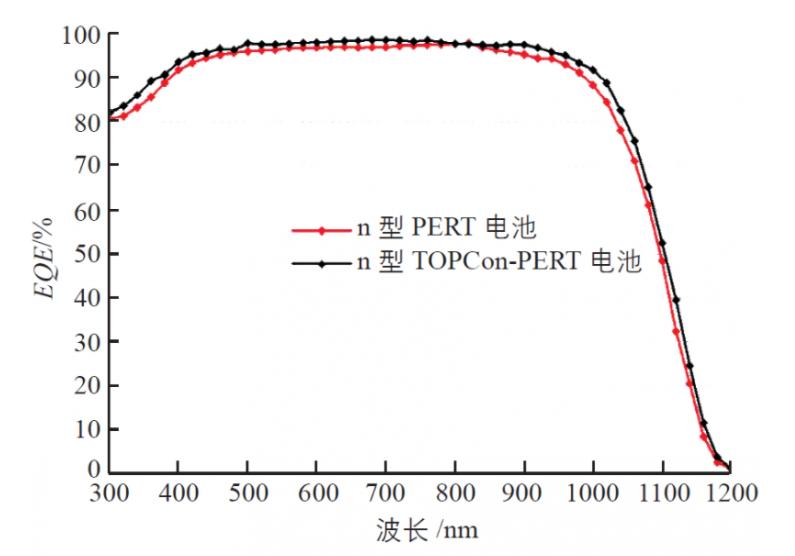
It can be seen from Figure 1 that the EQE of n-type TOPCon-PERT cells is higher than that of n-type PERT cells in both short-wave and long-wave bands. The reason is that the improvement of the EQE of the n-type TOPCon-PERT cell in the short-wave band is mainly due to the optimization of the boron diffusion process, which reduces the recombination rate of the front surface of the cell; and its improvement in the long-wave band is mainly due to the advantages of the TOPCon structure. This structure makes the whole backside of the battery better passivated, effectively reduces the recombination rate of the backside of the battery, especially the metal contact area, and improves the light absorption rate of the battery[5-6].
In order to further study the spectral response characteristics of the n-type TOPCon-PERT cell, the IQE, EQE and reflectivity of the front and back of the cell were tested respectively. The test results are shown in Figure 2.
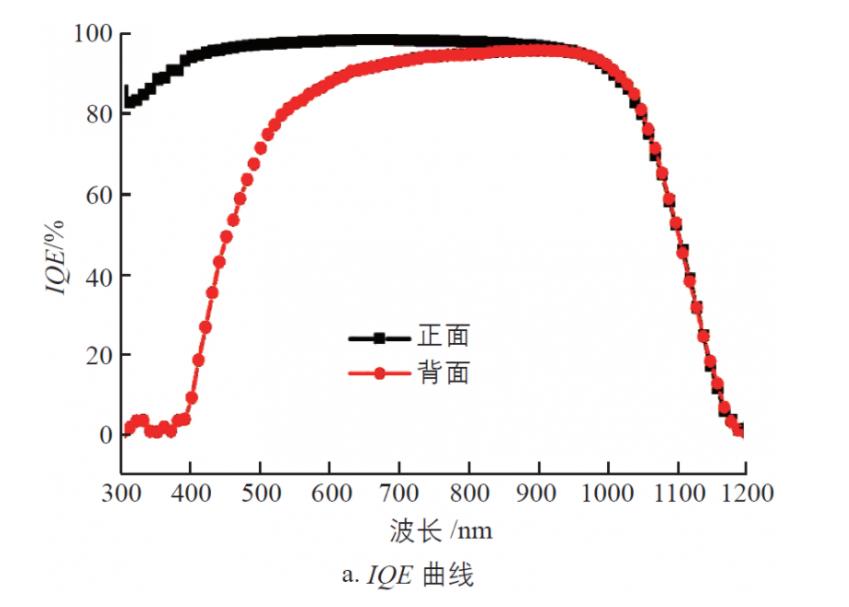
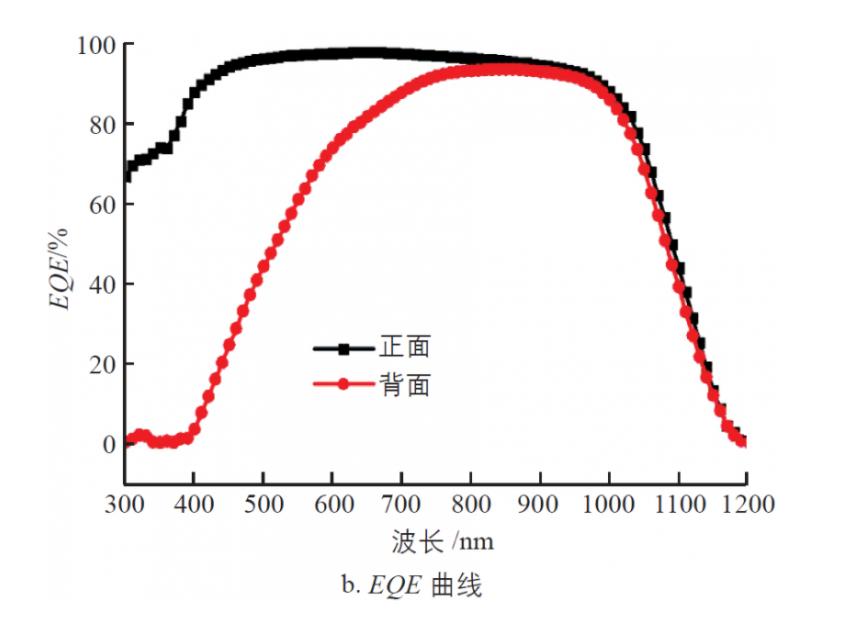
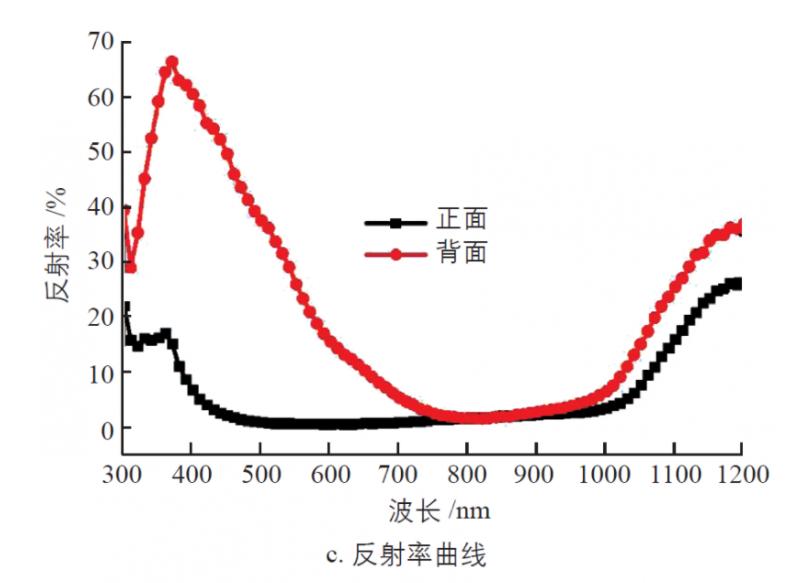
It can be seen from Fig. 2 that the spectral response of the front side of the n-type TOPCon-PERT cell is better, and the reflectivity of the front side is lower, and the utilization rate of incident photons is higher. This is mainly because there are differences in the penetration coefficient and energy distribution of photons in different wavelength bands. Short-wave photons have weak penetration and are mostly absorbed on the surface of the battery; while long-wave photons have strong penetration and are mostly absorbed in the battery. Internally absorbed. However, as the wavelength becomes longer, the photon energy decreases, and the IQE and EQE on the front side of the battery also decrease after 1000 nm; at the same time, due to the relatively high doping concentration of the p-n junction formed by the n-type silicon wafer, the p+ emitter junction is deeper. , Auger recombination is more serious, so the spectral response of the front of the battery in the short-wave band of 300-400 nm is relatively low. The difference between the reflectivity of the front and back of the cell is determined by the structure of the double-sided cell. Since the silicon wafer of the double-sided solar cell needs to be textured on both sides, when the boron diffuses, the boron atoms diffused on the front will diffuse to the back at the same time. Therefore, it is necessary to etch the part that has diffused over the boundary, and in the process, the textured structure on the back of the silicon wafer will be destroyed, so that the light trapping effect of the back is weakened compared with that of the front.
2 Analysis of outdoor empirical power generation characteristics
In the same desert area in northwestern my country, the same photovoltaic power generation system design was used to compare the annual power generation of n-type TOPCon-PERT modules, n-type PERT modules and p-type PERC modules with an installed capacity of 1 MWp in 2019. The results are as follows: shown in Table 1. As can be seen from the table, the annual power generation of n-type TOPCon-PERT modules is 0.7% higher than that of n-type PERT modules and 1.6% higher than that of p-type PERC modules. It can be seen that compared with the p-type PERC module, the n-type TOPCon-PERT module has a significant gain in power generation; and compared with the n-type PERT module, the TOPCon structure brings it a better power generation increase. .
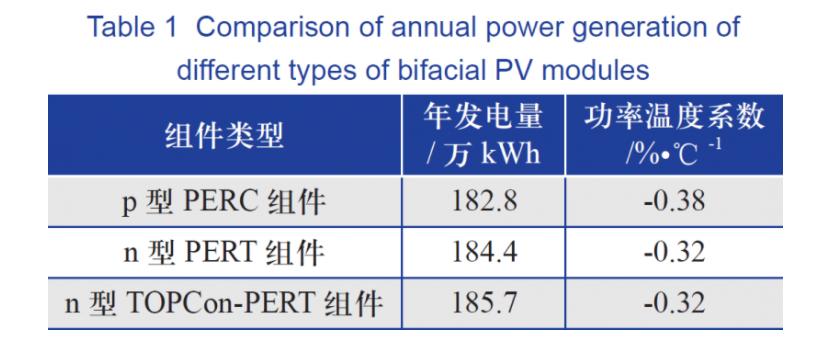
Analysis of the reasons for the difference in the power generation of the above three types of bifacial photovoltaic modules believes that the short-wave spectrum in the northwest desert region of my country is stronger than the AM1.5 standard solar spectrum distribution, which has more power generation advantages for n-type TOPCon-PERT cells; at the same time, The temperature loss and attenuation loss of different types of bifacial photovoltaic modules during operation are also important reasons for the difference in power generation [7].
2.1 Analysis of temperature loss during component operation
The temperature loss is determined by the power temperature coefficient of the photovoltaic module and the operating temperature. Due to the different power temperature coefficients of different types of photovoltaic modules, the rate of change of the module power with the operating temperature is different, so the electrical performance of the photovoltaic module output under different operating temperatures is also different.
The output power of the solar cell is determined by the working current and the working voltage. The working voltage is determined by the forbidden band width of the semiconductor material and the Fermi level. As the temperature increases, the Fermi level will be closer to the valence band, and the working voltage will be It becomes smaller in a larger range; while the operating current is affected by temperature very little. When the working current I is basically unchanged and the working voltage U changes greatly, it can be known from the formula P=UI of the power P that the change trend of the power is basically the same as that of the working voltage. Therefore, the larger the power temperature coefficient and the higher the operating temperature, the greater the influence of temperature on the power generation of photovoltaic modules when operating under the same conditions. It can be seen from Table 1 that the power temperature coefficients of the two n-type bifacial photovoltaic modules are 0.06%/°C lower than that of the p-type bifacial photovoltaic modules, and the temperature of the modules can reach 70°C during operation. Due to the low power temperature coefficient of the n-type TOPCon-PERT module, its temperature loss is relatively small in summer when the ambient temperature is high, and the temperature loss in winter is basically the same as that of the other two bifacial photovoltaic modules.
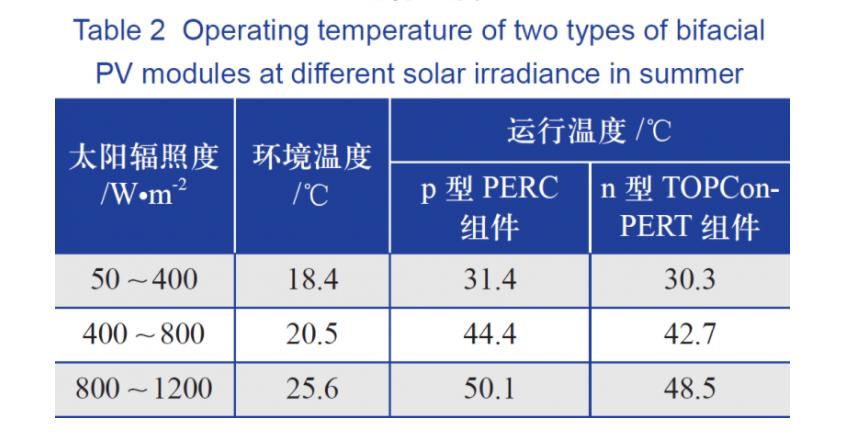
The operating temperatures of p-type PERC modules and n-type TOPCon-PERT modules under different solar irradiances (solar irradiance>50 W/m2) in summer were further collected, as shown in Table 2. It can be found from the table that the overall operating temperature of the n-type TOPCon-PERT module is lower than that of the p-type PERC module, so its temperature loss is relatively small.
2.2 Attenuation loss analysis of components
Attenuation loss is also one of the important factors affecting the power generation of photovoltaic modules. During the operation of the power station, the power generation of photovoltaic modules decreases year by year with the attenuation of the modules. The comprehensive attenuation rate of photovoltaic modules generally mainly includes the light-induced attenuation of solar cells and the aging attenuation of materials, and the aging attenuation of materials is a common phenomenon in various photovoltaic modules. In order to understand the attenuation characteristics of p-type PERC modules and n-type TOPCon-PERT modules, an online I-V tester was installed on the module support, and the attenuation characteristics of the two modules were empirically analyzed. Through the I-V curve and meteorological data, the calculation results of the decay rate are converted to the same conditions for comparison, as shown in Table 3.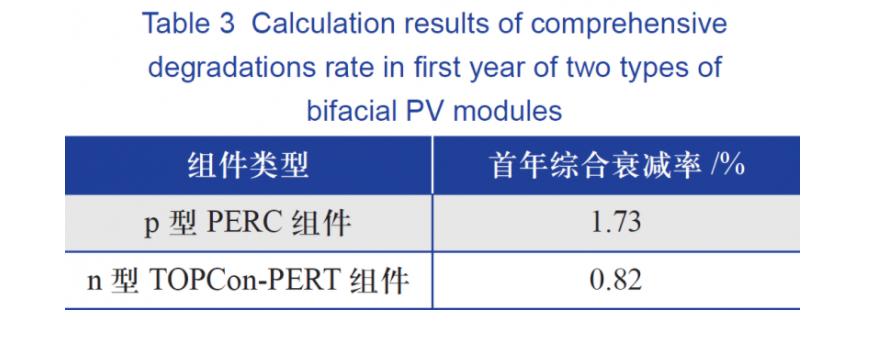
Since the silicon wafer of the p-type PERC module used in the experiment adopts a B-doped process, there is a B-O complex inside the silicon wafer, which leads to photo-induced attenuation of the cell; however, under light conditions, the B-O compound inside the silicon wafer of this type of cell is compounded. The B-O complexes will become activated and form defect levels, so pretreatment and supplemental illumination will further re-inactivate the B-O complex from the activated state, and the battery performance can be restored. However, the cell silicon wafer of the n-type TOPCon-PERT module does not contain B-O complex, so there is basically no light-induced attenuation phenomenon.
It can be seen from Table 3 that the first-year comprehensive attenuation rate of the two bifacial photovoltaic modules differs by 0.91%, which indicates that the anti-fading characteristics of n-type TOPCon-PERT modules are better than that of p-type PERC modules. The light-induced attenuation of the battery mainly occurs in the first year, accompanied by a small aging of the material. After that, the light-induced attenuation of the battery is basically completed, and the attenuation method is mainly the aging of the material. Since the main raw materials and auxiliary materials used in these two bifacial photovoltaic modules are the same, it can be considered that the aging attenuation rates of the two materials are basically similar, which also shows that the overall anti-decay characteristics of n-type TOPCon-PERT cells are better than that of p-type cells. PERC battery.
3 Conclusion
This paper analyzes the IQE and EQE of the n-type TOPCon-PERT cell itself, and compares the EQE of the n-type TOPCon-PERT cell with that of the n-type PERT cell, and finally analyzes the n-type TOPCon-PERT module and the other two bifacial The following conclusions are drawn from the outdoor power generation characteristics and attenuation rate of photovoltaic modules:
1) The EQE curve of n-type TOPCon-PERT battery is generally better than that of n-type PERT battery, and it is more obvious in both short-wave and long-wave bands.
2) Compared with the n-type PERT module, the n-type TOPCon-PERT module has an annual power generation gain of 0.7%, which is more economical.